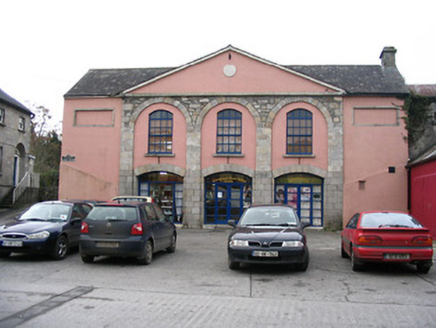Survey Data
Reg No
12318044
Rating
Regional
Categories of Special Interest
Architectural, Historical, Social
Original Use
Market house
Historical Use
Court house
Date
1790 - 1839
Coordinates
270923, 143643
Date Recorded
17/05/2004
Date Updated
--/--/--
Description
Detached five-bay two-storey market house, extant 1839, on a symmetrical plan centred on three-bay full-height pedimented breakfront; single-bay two-storey elevations. Reconstructed, 1994-6. Replacement pitched slate roof centred on pitched (gabled) slate roof (breakfront), ridge tiles, rooflights to rear (west) pitch, and remains of cast-iron rainwater goods on cut-granite eaves. Replacement cement rendered walls; part repointed granite ashlar pilasters (breakfront) on cut-granite chamfered plinths supporting cut-granite monolithic pediment. Series of three camber-headed central openings in round-headed recesses with granite ashlar voussoirs framing replacement glazed timber double doors having sidelights below overlights. Camber-headed window openings (first floor) with cut-granite sills, and concealed dressings framing replacement timber casement windows replacing nine-over-six pivoted timber sash windows without horns. Set back from street with concrete forecourt.
Appraisal
A market house 'built by Lord Clifden [Henry Welbore Agar-Ellis (1761-1836)]' (Lewis 1837 I, 668) representing an important component of the early nineteenth-century built heritage of Graiguenamanagh with the architectural value of the composition confirmed by such attributes as the symmetrical footprint centred on a Classically-detailed breakfront demonstrating good quality workmanship in a silver-grey granite; the characteristic arcade; the diminishing in scale of the openings on each floor producing a graduated tiered visual effect; and the monolithic pediment embellishing the roof. NOTE: A recent plaque records that 'on Sunday 24th October 1830 the first meeting of the anti-tithe campaign that signalled the commencement of the Tithe War [1830-6] was held here... A century later Éamon de Valera [1882-1975] and William Thomas Cosgrave [1880-1965] addressed the people from its windows'.

